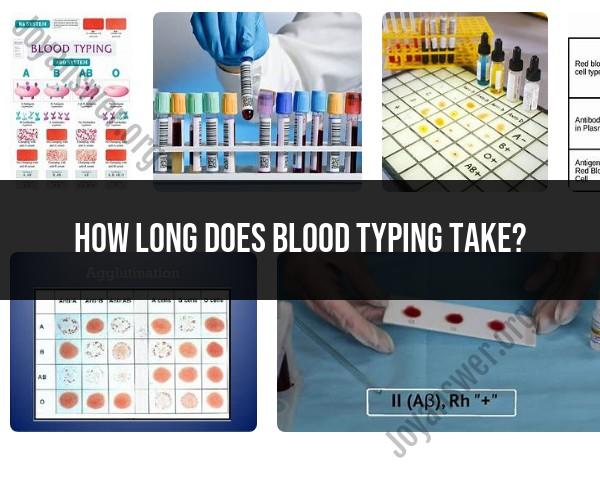How long does blood typing take?
The duration for blood typing can vary depending on the specific method used and the laboratory or healthcare facility performing the test. In general, blood typing is a relatively quick process, and results are often available within a short period. Here's an overview of the typical time frame for blood typing:
Traditional Blood Typing (Manual Methods):
- Traditional blood typing methods involve serological techniques, such as the use of antisera to detect the presence or absence of ABO and Rh antigens on red blood cells.
- In a laboratory setting, these methods may take about 15 to 30 minutes to complete.
Automated Blood Typing Systems:
- Many modern laboratories use automated blood typing systems that streamline the process and provide results more rapidly.
- Automated systems can significantly reduce the time required for blood typing, and results may be available in as little as 5 to 10 minutes.
Point-of-Care Testing:
- In certain settings, especially in emergency situations or smaller healthcare facilities, point-of-care testing may be used.
- Point-of-care tests can provide blood typing results within a few minutes, allowing for quick decision-making in urgent situations.
Blood Transfusion Compatibility Testing:
- If blood typing is performed to determine compatibility for a blood transfusion, additional steps may be involved, such as crossmatching.
- Crossmatching, which ensures compatibility between the donor's blood and the recipient's blood, may add some time to the overall process.
It's important to note that the above time frames are general estimates, and the actual time taken for blood typing can be influenced by factors such as the laboratory's equipment, workflow, and the specific testing protocols in use. Additionally, some healthcare facilities may have rapid response capabilities for urgent situations.
In emergency situations where immediate blood typing results are critical, point-of-care testing or expedited laboratory procedures may be employed to provide timely information for medical decision-making. Always consult with the healthcare professionals or laboratory staff involved in the testing process for specific information about the duration of blood typing in a particular setting.
1. Understanding the Factors Affecting Blood Typing Time
Blood typing time can be influenced by various factors, including the type of test being performed, the number of samples being analyzed, and the availability of resources in the laboratory setting.
Type of Test: Different blood typing methods have varying turnaround times. Automated blood typing systems, often used in routine laboratory settings, typically provide results within minutes. However, more specialized tests, such as molecular typing, may require several hours or even days to complete.
Number of Samples: The number of blood samples being processed can also affect turnaround time. Analyzing multiple samples simultaneously can extend the overall processing time, especially if limited resources are available.
Laboratory Workload: The overall workload of the laboratory can also impact blood typing time. During peak periods or when handling high volumes of samples, turnaround times may increase due to increased demand on laboratory resources.
Technical Issues: Technical issues, such as equipment malfunctions or reagent shortages, can also lead to delays in blood typing results. These unforeseen circumstances may require troubleshooting and corrective actions, extending the processing time.
Typical blood typing turnaround time for routine blood tests
For routine blood tests, the turnaround time for blood typing is generally within a few hours. Automated blood typing systems can provide results within minutes, while manual techniques may take up to an hour or two. However, the exact turnaround time may vary depending on the laboratory's procedures and workload.
Expedited blood typing procedures for urgent medical situations
In urgent medical situations, such as when a patient requires an emergency blood transfusion, expedited blood typing procedures are employed to minimize delays. These procedures may involve:
Prioritizing the sample: Urgent blood samples are prioritized for processing, ensuring that they are analyzed ahead of routine samples.
Using rapid blood typing methods: Laboratories may utilize rapid blood typing methods, such as immunochromatography-based tests, which can provide results within minutes.
Streamlining laboratory procedures: Laboratories may streamline their processes to reduce turnaround time, such as having designated personnel dedicated to urgent blood typing.
4. Factors that May Delay Blood Typing Results
Despite efforts to expedite blood typing, certain factors may still cause delays in obtaining results:
- Incomplete or Mislabeled Samples: Errors in sample collection or labeling can lead to delays as the laboratory investigates and corrects the











